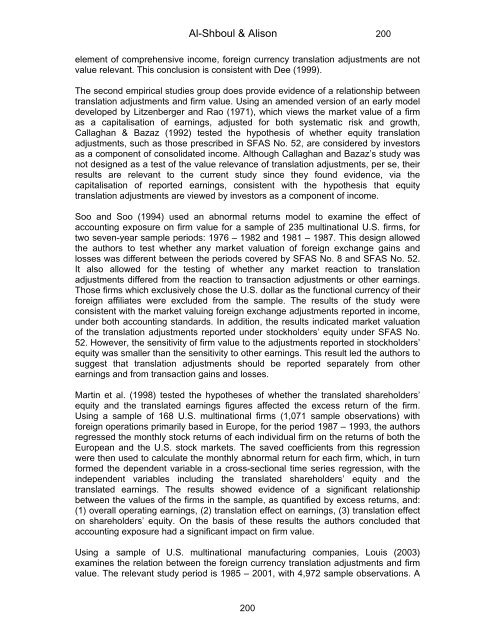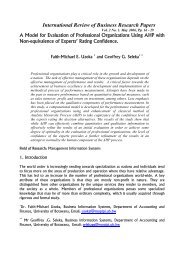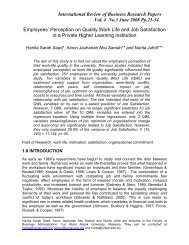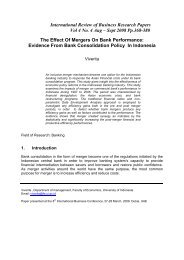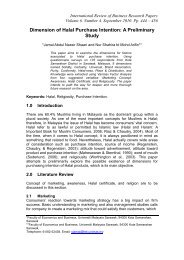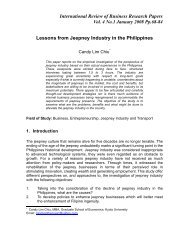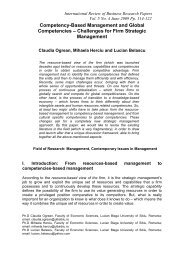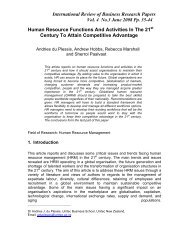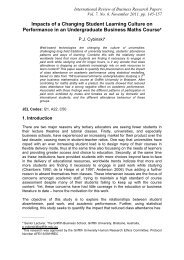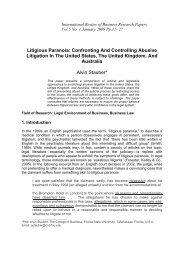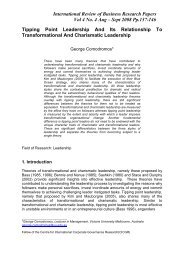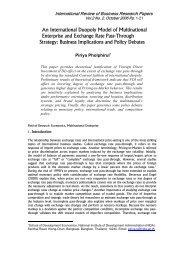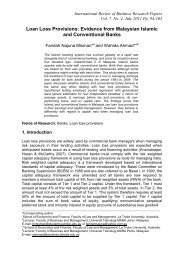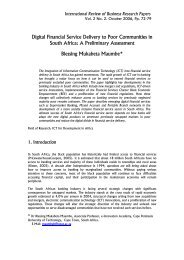Translation Exposure and Firm Value, Evidence From Australian ...
Translation Exposure and Firm Value, Evidence From Australian ...
Translation Exposure and Firm Value, Evidence From Australian ...
You also want an ePaper? Increase the reach of your titles
YUMPU automatically turns print PDFs into web optimized ePapers that Google loves.
Al-Shboul & Alison 200element of comprehensive income, foreign currency translation adjustments are notvalue relevant. This conclusion is consistent with Dee (1999).The second empirical studies group does provide evidence of a relationship betweentranslation adjustments <strong>and</strong> firm value. Using an amended version of an early modeldeveloped by Litzenberger <strong>and</strong> Rao (1971), which views the market value of a firmas a capitalisation of earnings, adjusted for both systematic risk <strong>and</strong> growth,Callaghan & Bazaz (1992) tested the hypothesis of whether equity translationadjustments, such as those prescribed in SFAS No. 52, are considered by investorsas a component of consolidated income. Although Callaghan <strong>and</strong> Bazaz’s study wasnot designed as a test of the value relevance of translation adjustments, per se, theirresults are relevant to the current study since they found evidence, via thecapitalisation of reported earnings, consistent with the hypothesis that equitytranslation adjustments are viewed by investors as a component of income.Soo <strong>and</strong> Soo (1994) used an abnormal returns model to examine the effect ofaccounting exposure on firm value for a sample of 235 multinational U.S. firms, fortwo seven-year sample periods: 1976 – 1982 <strong>and</strong> 1981 – 1987. This design allowedthe authors to test whether any market valuation of foreign exchange gains <strong>and</strong>losses was different between the periods covered by SFAS No. 8 <strong>and</strong> SFAS No. 52.It also allowed for the testing of whether any market reaction to translationadjustments differed from the reaction to transaction adjustments or other earnings.Those firms which exclusively chose the U.S. dollar as the functional currency of theirforeign affiliates were excluded from the sample. The results of the study wereconsistent with the market valuing foreign exchange adjustments reported in income,under both accounting st<strong>and</strong>ards. In addition, the results indicated market valuationof the translation adjustments reported under stockholders’ equity under SFAS No.52. However, the sensitivity of firm value to the adjustments reported in stockholders’equity was smaller than the sensitivity to other earnings. This result led the authors tosuggest that translation adjustments should be reported separately from otherearnings <strong>and</strong> from transaction gains <strong>and</strong> losses.Martin et al. (1998) tested the hypotheses of whether the translated shareholders’equity <strong>and</strong> the translated earnings figures affected the excess return of the firm.Using a sample of 168 U.S. multinational firms (1,071 sample observations) withforeign operations primarily based in Europe, for the period 1987 – 1993, the authorsregressed the monthly stock returns of each individual firm on the returns of both theEuropean <strong>and</strong> the U.S. stock markets. The saved coefficients from this regressionwere then used to calculate the monthly abnormal return for each firm, which, in turnformed the dependent variable in a cross-sectional time series regression, with theindependent variables including the translated shareholders’ equity <strong>and</strong> thetranslated earnings. The results showed evidence of a significant relationshipbetween the values of the firms in the sample, as quantified by excess returns, <strong>and</strong>:(1) overall operating earnings, (2) translation effect on earnings, (3) translation effecton shareholders’ equity. On the basis of these results the authors concluded thataccounting exposure had a significant impact on firm value.Using a sample of U.S. multinational manufacturing companies, Louis (2003)examines the relation between the foreign currency translation adjustments <strong>and</strong> firmvalue. The relevant study period is 1985 – 2001, with 4,972 sample observations. A200


